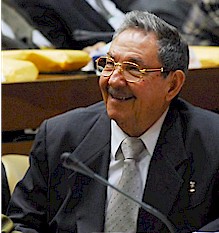
Cuban President Raul Castro Ruz at the National Assembly where he was officially elected on Feb. 24, 2008. His brother Fidel remains head of the Communist Party., a photo by Pan-African News Wire File Photos on Flickr.
Havana
November 22, 2012
Symbol of the Revolution’s commitment to the people
• On November 9, 1932, a hurricane left more than 3,000 victims in its wake in Santa Cruz del Sur, Camagüey. On November 8, 2008, Hurricane Paloma put the will of its inhabitants to the test once again, but this time it was a different story
Miguel Febles Hernández
IT seemed like fate when, a few hours before the people of Santa Cruz del Sur in Camagüey province honored the 3,000 people who lost their lives to a hurricane in 1932, another one with the deceptively gentle name of Paloma (Dove) hit this fishing community in 2008.
"What Paloma, that’s no Paloma! They should have called it Gavilán (Seagull)
for the damage it did to us," commented José del Risco Guerra, a fisherman for many years, whose home, located a few meters from the coast, was seriously damaged by the hurricane’s impact.
"When we got back from the evacuation center in Camagüey, there was nothing but destruction here, everything in ruins. The fuel tank in the nearby store turned up in my house after breaking through one of the side walls."
How many dead did Paloma leave?
"Not one. Hours before it struck, all those of us living near the beach were in secure places."
Del Risco, with his wife and family, already have an apartment in a building about to be inaugurated in La Franja, constructed a few kilometers’ distance from the area of greatest danger in the event of tropical storms.
NOBODY WAS LEFT HOMELESS
"Revolutionaries do not surrender to the enemy or to hurricanes; they trust in the Revolution, as we trust in you," President Raúl Castro Ruz affirmed to the people of Santa Cruz then. His words mobilized their collective will to overcome the situation.
Those who met then with the Cuban President included senior citizens Elia Rosa Pérez Acosta and her husband Wilfredo Sánchez Cabeza (recently deceased), survivors of the ’32 hurricane, considered the worst natural disaster to have occurred in Cuba.
"Raúl was very nice. He posed for a number of photos with us, asked us lots of questions and finally told us that they would work to ensure we got another, better house," recalled Elia Rosa in her new apartment, keeping a close eye on the lively Nicel, barely eight months of age when Paloma struck.
"I was left motherless when I was only three years old and also lost other family members in that terrible storm. They said that I appeared looking half dead. But this time, we were very well looked after and no one was left homeless or abandoned to their fate."
RESOUNDING RESPONSE
Pablo Peribáñez Hernández, president of the Municipal Assembly of People's Power in Santa Cruz del Sur, is fully informed of every details of the recovery program in the area, which has involved the mobilization of substantial human, material and financial resources.
"Just to mention the housing sector, 10,210 homes were damaged in some way (close to 58% of local housing stock), and 1,507 of them were totally destroyed. Then there was the damage inflicted on the productive infrastructure and that of services."
From the beginning of the recovery phase, involving the integrated forces of the Ministry of Construction, the Revolutionary Armed Forces and the Ministry of the Interior, to date, 60 buildings with 364 apartments have been completed, providing around 1,200 Santa Cruz families with new and comfortable homes.
Peribáñez Hernández stated that another 700 houses had been built by local residents themselves, an effort which is ongoing and functions through the sale of materials and the granting of subsidies, 70% of which were approved to restore homes affected by Paloma.
"We’ve had to work hard and without respite to achieve all of this," he explained, but confirmed that in spite of the economic problems experienced by the country, the municipal recovery program has continued and 83% of the goals set have been met.
A COMMUNITY AND ITS PEOPLE
Less than 15 months after Hurricane Paloma’s passing over the municipality, the stricken city had a new community of 51 two-story buildings, with the corresponding services and an elementary school with a student body of 246 pupils.
Located more than four kilometers from the coast the 50 Aniversario district sheltered hundreds of families who had lost their homes and now stands as an unequivocal symbol of the power of the country’s response to adversities of any kind.
"I am more than grateful for this gesture of the Revolution. My family is now enjoying a real home, because the only thing Paloma left me was the floor of the last one," affirmed Andrés Pérez Mendoza, with more than 40 years’ experience in shrimp fishing.
Is this one the same as the one you had?
"Oh no, nothing like it. I never imagined I’d have an apartment like this, so good: spacious, airy, three bedrooms, far from the danger of the sea. We feel great here."
Having said that, he left quickly for the coast, where El Espanto, a small fishing vessel was waiting to take him on another fishing trip, without any other preoccupations and confident that his family is well protected.
No comments:
Post a Comment